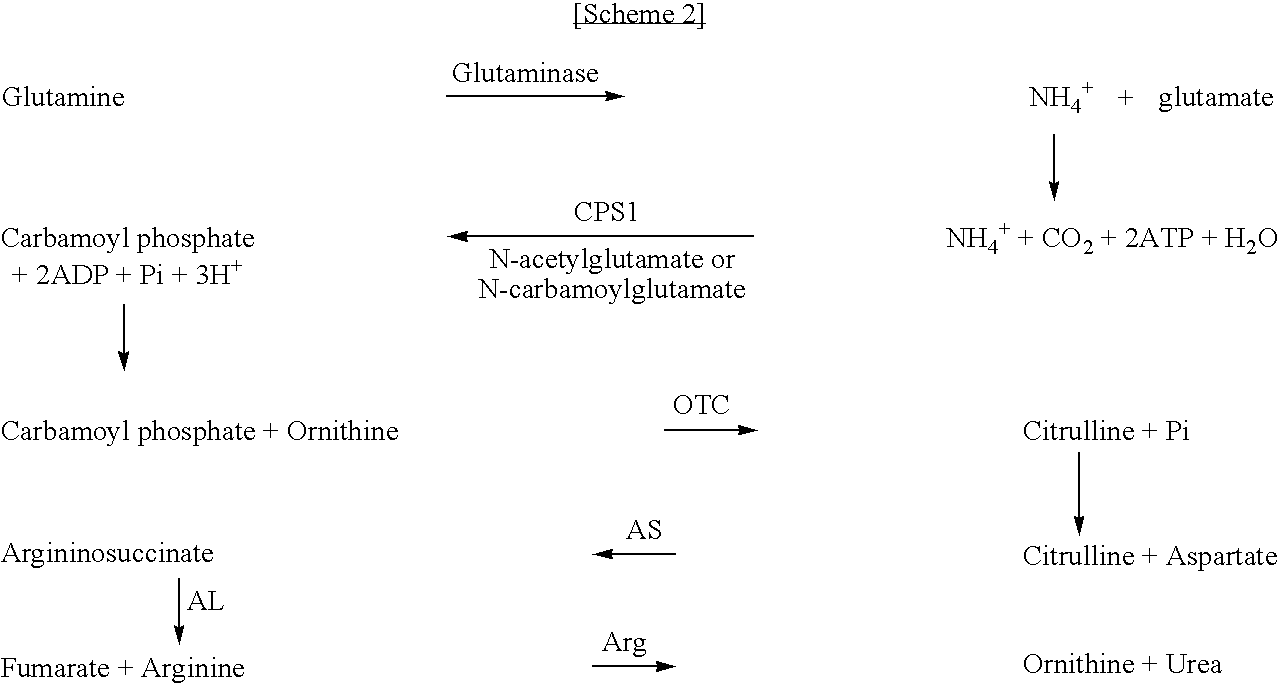Expression vector containing urea cycle enzyme gene, transformant thereof, and use of transformant for protein over-expression
a technology of urea cycle enzyme and transformant, which is applied in the direction of transferases, enzymology, organic chemistry, etc., can solve the problems of inability to maximize the production of such proteins with physiological activity, toxic ammonium ion overdose, and inability to inhibit cell growth
- Summary
- Abstract
- Description
- Claims
- Application Information
AI Technical Summary
Benefits of technology
Problems solved by technology
Method used
Image
Examples
example 1
Preparation of CPS I Expression Plasmid
[0050]In order to prepare CPS I expression plasmid, a full coding region of CPS I cDNA was cloned by the method of RT-PCR. To perform RT-PCR, use was made of total RNA from rat liver with a forward primer having a sequence number 13 and a backward primer having a sequence number 14. With a Titan™ one-tube RT-PCR system (supplied by Boehringer Mannheim, Germany) according to the protocol specified by the manufacturer, the RT reaction was performed in a Personal cycler (supplied by Biometra, Germany) at 50° C. for 30 minutes. After incubation at 94° C. for 2 minutes, the reaction mixture was kept at 94° C. for 30 seconds, at 49° C. for 30 seconds and at 72° C. for 1 minute, which cycle was repeated thirty times. Finally, the RT-PCR mixture was kept at 72° C. for 7 minutes and subjected to electrophoresis on a 0.9% agarose gel. RT-PCR product about 4.5 kb in size was identified by the staining gels with ethidium bromide (EtBr). The DNA fragment wa...
example 2
Preparation of OTC Expression Plasmid
[0051]To prepare OTC expression plasmid, RT-PCR was performed in the same manner as described in Example 1, except that use was made with a forward primer having a sequence number 3 and a backward primer having a sequence number 4. After carrying out RT reaction at 50° C. for 30 minutes, PCR was performed with 35 time repetitions of a cycle consisting of 30 second incubation at 94° C., 30 second incubation at 56° C. and at 45 second incubation at 72° C. As a result, DNA about 1064 bp in length was obtained. The DNA was inserted into a pCR2.1 vector (supplied by Invitrogen Co., U.S.A.) using a TA cloning kit (supplied by Invitrogen Co., U.S.A.) to prepare a pCR2.1-OTC1 plasmid. Subsequently, the pCR2.1-OTC1 plasmid was fragmented with an EcoRI enzyme to obtain an OTC fragment. The OTC fragment was then inserted into a pcDNA3.1(+) vector (supplied by Invitrogen Co., U.S.A.) to complete a pcDNA(+)-OTC1 recombinant plasmid.
[0052]The pcDNA(+)-OTC1 rec...
example 3
Preparation of AS Expression Plasmid
[0053]A full coding region of AS cDNA was cloned by using the RT-PCR method. For RT-PCR, use was made of a total RNA from a rat liver, with a forward primer having a sequence number 5 and a backward primer having a sequence number 6 that were based upon the rat AS cDNA (Ref. Serh et al., Nucleic Acids Res. 16, 9352–9352, 1990). RT-PCR was performed with a One-step RT-PCR kit-AMV (supplied by Takara Co., Japan). RT reaction was carried out at 50° C. for 30 minutes and then PCR was performed. After incubating at 94° C. for 2 minutes, 30 cycles of PCR were performed. The cycle was consisted of incubation at 94° C. for 30 seconds, at 49° C. for 30 seconds and at 72° C. for 45 seconds. RT-PCR product about 1200 bp was identified by an agarose gel electrophoresis. This PCR product was inserted between the CMV promotor of a pcDNA3.1 (+) / V5 / His-TOPO vector (supplied by Invitrogen Co., U.S.A.) and a BGH (Bovine Browth Hormone) polyadenylation signal (A) th...
PUM
| Property | Measurement | Unit |
|---|---|---|
| concentration | aaaaa | aaaaa |
| pH | aaaaa | aaaaa |
| pH | aaaaa | aaaaa |
Abstract
Description
Claims
Application Information
 Login to View More
Login to View More - R&D
- Intellectual Property
- Life Sciences
- Materials
- Tech Scout
- Unparalleled Data Quality
- Higher Quality Content
- 60% Fewer Hallucinations
Browse by: Latest US Patents, China's latest patents, Technical Efficacy Thesaurus, Application Domain, Technology Topic, Popular Technical Reports.
© 2025 PatSnap. All rights reserved.Legal|Privacy policy|Modern Slavery Act Transparency Statement|Sitemap|About US| Contact US: help@patsnap.com



